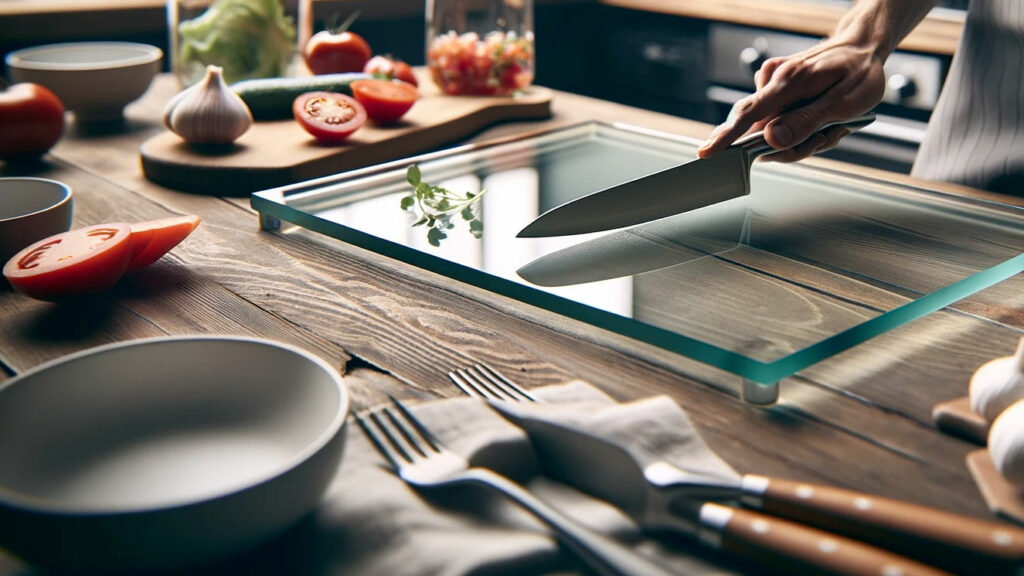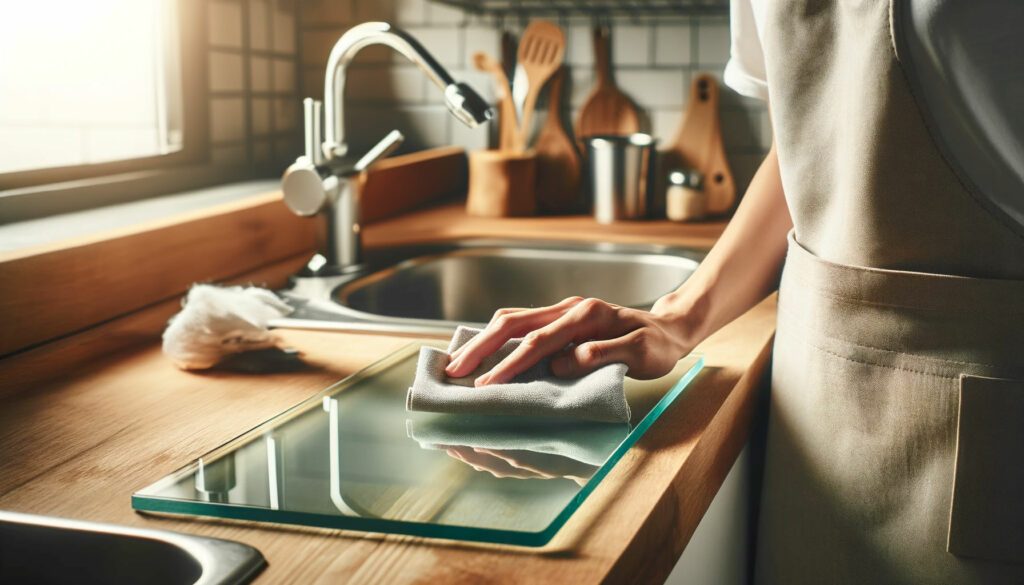
Glass Cutting Boards: Explore Benefits and Drawbacks
This post may contain affiliate links, meaning we may receive a small commission at no cost for you, if you purchase through these links.
Glass cutting boards have become a modern staple in many kitchens, combining aesthetic elegance with unique functional aspects. They stand out for their sleek design, often acting as a symbol of contemporary kitchenware. However, the question arises: are they as practical as they are stylish? This comprehensive exploration will delve into the various facets of glass cutting boards, analyzing their advantages and disadvantages to provide a holistic view. Understanding these aspects is crucial for anyone considering incorporating glass cutting boards into their kitchen repertoire, ensuring they make a choice that aligns with their culinary needs and lifestyle.

History of Glass Cutting Boards
The Evolution from Traditional to Modern
The history of cutting boards reflects the evolution of cooking and kitchen technology. Initially, simple wooden slabs served the purpose, but as culinary techniques advanced, so did the materials and designs of cutting boards. The introduction of glass represented a significant shift towards modernity, emphasizing not just functionality but also kitchen aesthetics. They were initially lauded for their sleek design, appealing to those who sought a more contemporary kitchen look. Over time, these boards have become a subject of debate among culinary professionals and home cooks alike, leading to a deeper examination of their practicality in comparison to traditional materials.
Introduction of Glass Cutting Boards
Glass entered the realm of kitchenware as a symbol of modern kitchen design. Its clear, clean appearance brought a new dimension to cutting boards, which were traditionally seen as purely functional. The shift to using glass was initially met with skepticism, primarily due to concerns about its practicality and safety. However, as their use became more widespread, glass cutting boards began to be appreciated for their unique properties, leading to a more nuanced understanding of their role in the kitchen.
Advantages of Glass Cutting Boards
Aesthetic Appeal
The most apparent advantage of glass cutting boards is their visual appeal. Their sleek and minimalist design can blend seamlessly with any modern kitchen décor, making them a popular choice for those who value aesthetics in their cooking space. The translucent or decorative surfaces of these boards also allow them to double as stylish serving platters, adding a touch of elegance to the presentation of food. Moreover, glass cutting boards can be found in a variety of colors and designs, offering an opportunity to personalize kitchen spaces according to individual tastes and styles.
Hygiene and Easy to Clean
Glass cutting boards offer excellent hygiene benefits. Being non-porous, they don’t absorb liquids, odors, or harbor bacteria, making them a safer choice for food preparation, especially when dealing with raw meats or fish. Their smooth surface allows for easy wiping, and they are typically dishwasher safe, ensuring thorough cleaning and maintenance. Unlike wooden or plastic boards, glass doesn’t develop scratches or grooves where bacteria can accumulate, making it a more sanitary option in the long term.
Durability and Longevity
One of the key benefits of glass cutting boards is their durability. They are resistant to wear and tear, stains, and odors, which are common issues with other materials. This resistance contributes to their longevity, making them a cost-effective option over time. Glass cutting boards don’t require the oiling or conditioning needed for wooden boards, nor do they show the wear marks often seen on plastic boards. This durability ensures that glass cutting boards maintain their pristine appearance and functional qualities for a longer period.
Disadvantages of Glass Cutting Boards

Potential Damage to Knives
The most significant disadvantage of glass cutting boards is their impact on knives. The hard surface of the glass can quickly dull the blades, affecting the efficiency and precision of cutting tasks. Frequent knife sharpening becomes necessary, which can be inconvenient and potentially costly over time. For those who invest in high-quality knives, a glass cutting board may not be the most suitable option, as it can diminish the lifespan and effectiveness of their cutting tools.
Safety Concerns
Glass cutting boards pose certain safety concerns. Their smooth surface can be slippery, especially when wet, increasing the risk of accidents during cutting tasks. Additionally, there’s a risk of the glass board shattering or chipping if dropped, which can lead to serious safety hazards in the kitchen. This risk is particularly concerning in busy kitchen environments or in households with children, where the likelihood of dropping or mishandling kitchen tools is higher.
Limited Functionality
While these cutting boards are excellent for certain types of food preparation, they may not be the most versatile choice. Their hard surface is not ideal for tasks that require heavy chopping or pounding, such as breaking down poultry or tenderizing meat. This limitation can be a significant drawback for those who engage in a wide range of cooking tasks, as it necessitates having multiple types of cutting boards for different purposes.
Comparative Analysis with Other Materials
Glass vs. Wood
When comparing glass cutting boards to wood, several factors come into play. Wooden cutting boards have been a traditional choice due to their natural antibacterial properties and softer surface, which is gentler on knives. However, they require more maintenance, including regular oiling and thorough cleaning, as their porous nature can harbor bacteria and odors if not properly cared for. Wood also tends to show wear over time, which can affect its appearance and hygiene.
Glass vs. Plastic
Plastic chopping boards offer the advantages of being lightweight, versatile, and often more affordable than glass or wood. However, they are prone to scratches and grooves, which can harbor bacteria over time. Unlike glass, plastic cutting boards are less durable and need to be replaced more frequently due to wear and the development of deep cuts that can harbor bacteria.
Glass vs. Bamboo
Bamboo cutting boards are becoming increasingly popular due to their eco-friendly nature and durability. Similar to glass, bamboo is harder on knives but offers a slightly softer surface, making it a more knife-friendly option. Bamboo boards are also resistant to moisture and bacteria, but like wood, they require regular maintenance to maintain their condition and hygiene.
User Experiences and Reviews
Testimonials from Home Cooks and Chefs
The opinions on glass cutting boards vary among different users. Many home cooks appreciate the hygiene, ease of cleaning, and the modern look that they bring to their kitchens. They often highlight the convenience of having a low-maintenance and visually appealing kitchen tool. Professional chefs, on the other hand, tend to have reservations about them. The primary concerns revolve around the wear on knives and the potential safety issues. Some chefs also express a preference for the traditional feel and functionality of wood or the versatility of plastic boards.
These are pretty and sturdy. As I mentioned, they are the most sanitary cutting boards available. They don’t scratch and can be put directly in the dishwasher. I am tossing all my wooden and plastic boards.
Mary on Amazon
Love this! We had old plastic boards that slowly got mold in the ridges from the knife cuts. Obviously that is gross. This is perfect and I use it every night. It is so easy to wash off and sterilize between uses. Since it is clear, it looks nice and neat on the counter!
Logan on Amazon
This is so much better than a traditional wooden cutting board. I wish I’d purchased it sooner. It also has a very large surface.
Ko on Amazon
Survey Data on User Preferences
Surveys and consumer research show a divided preference for cutting board materials. Factors like cooking habits, the frequency of cooking, types of food prepared, and personal priorities (such as hygiene versus knife maintenance) play a significant role in users’ choices. Glass cutting boards often receive high marks for their ease of cleaning and aesthetic appeal, while some users steer away from them due to concerns about knife damage and safety.
Maintenance and Care

Cleaning Glass Cutting Boards Best Practices
Proper maintenance of glass cutting boards is relatively straightforward. They can be washed with warm, soapy water or placed in the dishwasher for convenience. Avoid using abrasive cleaners or scouring pads that can scratch the surface, as this can compromise the board’s appearance and hygiene. Regular cleaning after each use is essential to ensure the board remains hygienic and safe for food preparation.
Storage and Handling
Storing glass cutting boards requires careful consideration to prevent damage. They should be stored in a safe, stable place, preferably lying flat or in a secure upright position to prevent tipping or falling. Handling them, especially when wet, should be done with care to avoid slips or drops. Given their potential for breakage, it’s important to handle these boards with extra caution to ensure their longevity and safety in the kitchen.
Environmental Impact and Sustainability
Manufacturing Process
The manufacturing process of glass cutting boards involves significant energy consumption, and the materials used are not always environmentally friendly. The production of glass requires high temperatures and often involves chemicals that can be harmful to the environment. This aspect is an important consideration for those who prioritize environmental sustainability in their kitchenware choices.
Recyclability and Eco-friendliness
On the positive side, glass is fully recyclable, which adds a point to its sustainability score. This is particularly advantageous when compared to plastic cutting boards, which are often not recyclable and can contribute to plastic waste. The recyclability of glass makes it a more eco-friendly option in the long run, especially for those looking to reduce their environmental footprint.
Purchasing Tips for Glass Cutting Boards
Factors to Consider
When purchasing a glass cutting board, several factors should be considered to ensure you get a high-quality product. The size and thickness of the board are important, as thicker boards are generally more durable and less prone to breakage. The brand’s reputation for quality and customer service can also be a deciding factor. Additionally, consider the design and color of the board to ensure it fits your kitchen’s aesthetic.
Where to Buy Glass Cutting Boards
Quality glass cutting boards can be found at kitchenware stores or through online retailers. It’s advisable to read customer reviews and product descriptions carefully to understand the quality and features of the board you are considering. Recommendations from friends or family who have used them can also be valuable in making an informed decision.
Conclusion
In conclusion, glass cutting boards offer distinct advantages in terms of hygiene, aesthetics, and durability, but they also come with drawbacks such as potential knife damage and safety concerns. Whether a glass cutting board is the right choice depends on individual cooking habits, preferences, and priorities. By considering all factors, including environmental impact, maintenance, and user experiences, you can make an informed decision on whether a glass cutting board is the best fit for your kitchen.







